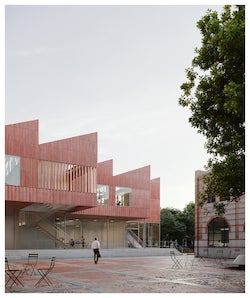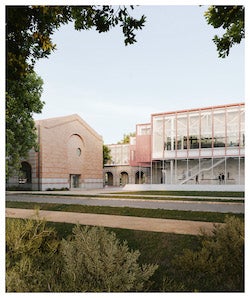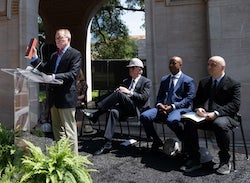Rice University broke ground this week for William T. Cannady Hall, a 22,000-square-foot building that will serve the renowned Rice School of Architecture.
The project was announced in 2019 shortly after lead donor Cannady retired following 55 years of teaching at Rice, and promptly unretired to become an adjunct professor at Rice's Jones School to teach the business of architecture. (Rice News profiled Cannady and his first half-century in 2014.)
"I am pragmatic and I believe steps can be taken to achieve your life's vision," said Cannady, a professor emeritus of architecture, to an overflowing crowd in the Rice Architecture courtyard on Sept. 15. "I've tried to build my life based on workable activities in architecture, construction and teaching the fundamentals of designing and building in the real world. I'm blessed to have loved my career."
"He is one of the most recognized figures on campus and one of the most beloved figures amongst our alumni," said Rice President Reginald DesRoches of Cannady, noting the new facility will help Rice Architecture maintain its status "as one of the jewels of Rice and one of the truly premier architectural programs not just in the West, but around the world."
Sited across a courtyard and connected by an aerial walkway to Rice Architecture's longtime home, MD Anderson Hall, the new structure is designed by Jeannette Kuo and Ünal Karamuk of Swiss architecture firm Karamuk Kuo. It will house a two-story public gallery, flexible teaching areas, research and fabrication space, and is expected to open in Fall, 2023. The Linbeck Group is the general contractor.
"It's an aspirational building," said Igor Marjanović, the William Ward Watkin Dean of Rice Architecture. "It's not meant to be a traditional office space, or even classroom space. It's really designed as an open, collaborative space for faculty and students to work on new forms of design research."
He noted Cannady Hall's fabrication and digital technology shop will contain not only expanded spaces for material experimentation, but also a striking two-story installation area.
The building, Marjanović said, will combine contemporary and classical design concepts. "It uses terracotta, which is a historical material, but it's beautiful and slick and used in a contemporary way," he said. "There's lots of transparency, lots of openness to make the work of the school more visible to the wider community, including through a new public gallery for architectural drawings and works on paper, bringing together our highest aspirations for research and outreach within this singular new building."
Before breaking ground with his colleagues and then with his extended family, Cannady explained his motivation well.
"I made this contribution because I didn't want to be known only by my possessions," he said. "I made the gift to be useful and to belong to something more important than myself."
- Video
-
Video produced by Brandon Martin/Rice University
- Images for download
-

A rendering shows the east façade of Rice Architecture's William T. Cannady Hall. Rice University broke ground this week for the project designed by Jeannette Kuo and Ünal Karamuk of Swiss architecture firm Karamuk Kuo. (Credit: Karamuk Kuo/Rice Architecture)

A rendering shows the north façade of Rice Architecture's William T. Cannady Hall, which incorporates a two-story, glassed-in gallery that faces the main Loop Road at Rice University. (Credit: Karamuk Kuo/Rice Architecture)

Will Cannady displays a sample of terracotta that will enclose Cannady Hall. (Credit: Jeff Fitlow/Rice University)

Breaking ground, from left: Houston City Council member and Rice alumnus David Robinson, President Reginald DesRoches, Angela Caughlin, her husband Will Cannady, architecture dean Igor Marjanović and Board of Trustees Chairman Robert Ladd. (Credit: Jeff Fitlow/Rice University)

Rice President Reginald DesRoches, architecture dean Igor Marjanović and professor emeritus Will Cannady assemble before the Sept. 15 groundbreaking ceremony in the courtyard between Anderson Hall and the site of Cannady Hall. (Credit: Jeff Fitlow/Rice University)






